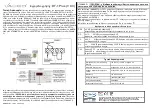
Teaming
NetXtreme
User Guide
Broadcom
®
April 2017 • 2CS57XX-CDUM514-R
Page 99
Smart Load Balancing™ and Failover
Smart Load Balancing™ and Failover is the Broadcom implementation of load balancing based on IP flow. This
feature supports balancing IP traffic across multiple adapters (team members) in a bidirectional manner. In this
type of team, all adapters in the team have separate MAC addresses. This type of team provides automatic fault
detection and dynamic failover to other team member or to a hot standby member. This is done independently
of the Layer 3 protocol (IP); rather, it works with existing Layer 2 and Layer 3 switches. No switch configuration
(such as trunk, link aggregation) is necessary for this type of team to work.
Link Aggregation (802.3ad)
This mode supports link aggregation and conforms to the IEEE 802.3ad (LACP) specification. Configuration
software allows you to dynamically configure which adapters you want to participate in a given team. If the link
partner is not correctly configured for 802.3ad link configuration, errors are detected and noted. With this mode,
all adapters in the team are configured to receive packets for the same MAC address. The outbound load-
balancing scheme is determined by our BASP driver. The team link partner determines the load-balancing
scheme for inbound packets. In this mode, at least one of the link partners must be in active mode.
Generic Trunking (FEC/GEC)/802.3ad-Draft Static
The Generic Trunking (FEC/GEC)/802.3ad-Draft Static type of team is very similar to the Link Aggregation
(802.3ad) type of team in that all adapters in the team are configured to receive packets for the same MAC
address. The Generic Trunking (FEC/GEC)/802.3ad-Draft Static) type of team, however, does not provide LACP
or marker protocol support. This type of team supports a variety of environments in which the adapter link
partners are statically configured to support a proprietary trunking mechanism. For instance, this type of team
could be used to support Lucent's OpenTrunk or Cisco's Fast EtherChannel (FEC). Basically, this type of team
is a light version of the Link Aggregation (802.3ad) type of team. This approach is much simpler, in that there is
not a formalized link aggregation control protocol (LACP). As with the other types of teams, the creation of teams
and the allocation of physical adapters to various teams is done statically through user configuration software.
The Generic Trunking (FEC/GEC/802.3ad-Draft Static) type of team supports load balancing and failover for
both outbound and inbound traffic.
Linux
Team adapters using the bonding kernel module and a channel bonding interface.
See your Linux documentation for more information.
Notes:
• If you do not enable LiveLink™ when configuring SLB teams, disabling Spanning Tree Protocol
(STP) at the switch or port is recommended. This minimizes the downtime due to spanning tree
loop determination when failing over. LiveLink mitigates such issues.
• If a team member is linked at 1000 Mbit/s and another team member is linked at 100 Mbit/s, most
of the traffic is handled by the 1000 Mbit/s team member.
Table 6: Types of Teams
Operating System
Available Types of Teams
Summary of Contents for NetXtreme BCM57 Series
Page 1: ...Broadcom NetXtreme BCM57XX User Guide Last revised April 2017 2CS57XX CDUM514 R...
Page 16: ...Functionality and Features NetXtreme User Guide Broadcom April 2017 2CS57XX CDUM514 R Page 16...
Page 169: ...Regulatory Information NetXtreme User Guide Broadcom April 2017 2CS57XX CDUM514 R Page 169...
Page 170: ...Regulatory Information NetXtreme User Guide Broadcom April 2017 2CS57XX CDUM514 R Page 170...
Page 171: ...Regulatory Information NetXtreme User Guide Broadcom April 2017 2CS57XX CDUM514 R Page 171...
















































